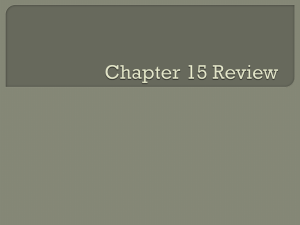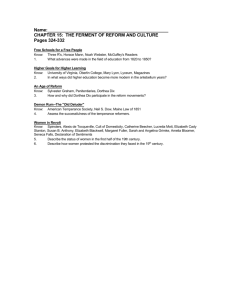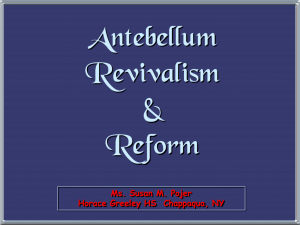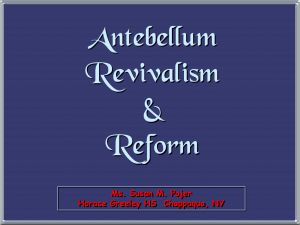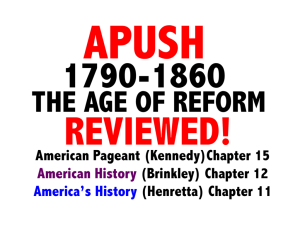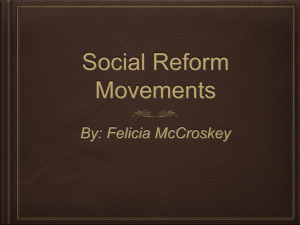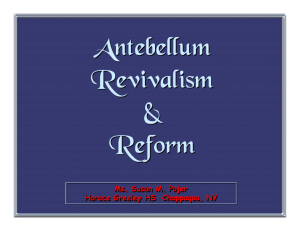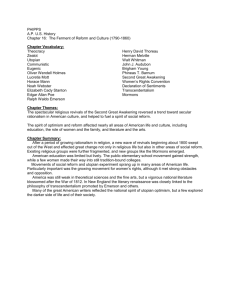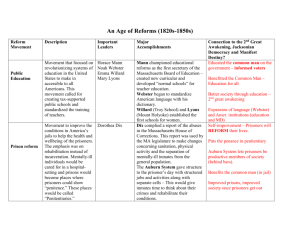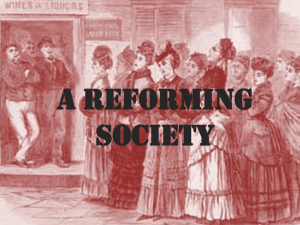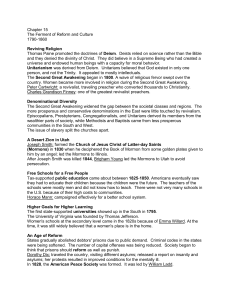Antebellum Reform Movements
advertisement
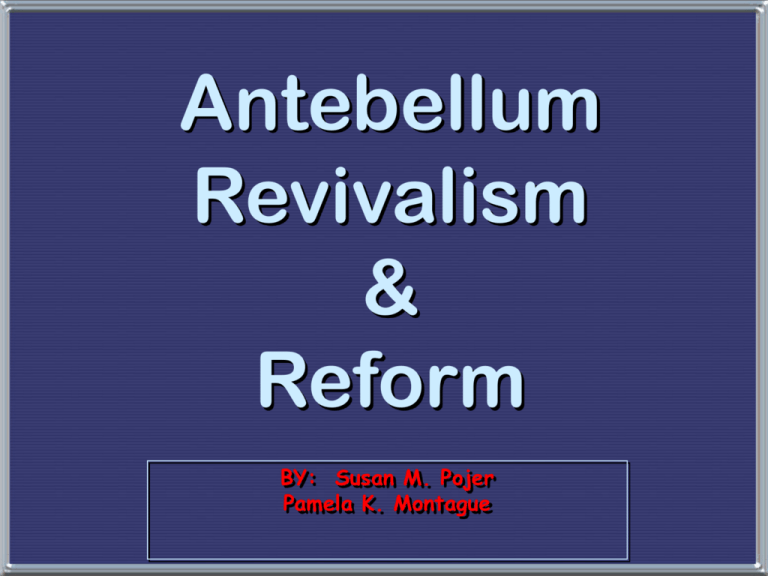
Antebellum Revivalism & Reform BY: Susan M. Pojer Pamela K. Montague The Rise of Popular Religion In France, I had almost always seen the spirit of religion and the spirit of freedom pursuing courses diametrically opposed to each other; but in America, I found that they were intimately united, and that they reigned in common over the same country… Religion was the foremost of the political institutions of the United States. -- Alexis de Tocqueville, 1832 The Second Great Awakening “Spiritual Reform From Within” [Religious Revivalism] Social Reforms & Redefining the Ideal of Equality Temperance Education Abolitionism Asylum & Penal Reform Women’s Rights “The Pursuit of Perfection” In Antebellum America How did the transportation revolution and the market revolution lead to this desire? “The Benevolent Empire”: 1825 - 1846 Where did the movement begin? The “Burned-Over” District in Upstate New York Many NE Puritans had settled there Second Great Awakening Revival Meeting Spread to the masses on the frontier by multi-day camp meetings Charles G. Finney (1792 – 1895) The ranges of tents, the fires, reflecting light…; the candles and lamps illuminating the encampment; hundreds moving to and fro…;the preaching, praying, singing, and shouting,… like the sound of many waters, was enough to swallow up all the powers of contemplation. “soul-shaking” conversion 2nd Great Awakening led to the feminization of religion - women make up majority of Church membership and move into charity work in the reform movements it sparked. The Mormons (The Church of Jesus Christ of Latter-Day Saints) 1823 Golden Tablets 1830 Book of Mormon 1844 Murdered in Carthage, IL Why? Joseph Smith (1805-1844) Violence Against Mormons Why were the Mormons persecuted? The Mormon “Trek” Why Utah? The Mormons (The Church of Jesus Christ of Latter-Day Saints) Deseret community Salt Lake City, Utah Frontier theocracy Later flouted what laws in UT? Brigham Young (1801-1877) Temperance Movement 1826 - American Temperance Society “Demon Rum”! Frances Willard Lyman Beecher & the Beecher Family Annual Consumption of Alcohol “The Drunkard’s Progress” From the first glass to the grave, 1846 What social problems were attributed to alcohol? NEAL DOW • Father of Prohibition • MAINE LAW, 1851 – First U.S. Law to ban the manufacture and sale of alcohol. • Temperance is the most widely supported, least sectional and most successful of all the reform movements • What groups will be most resistant? Early 19th Century Women – Rights? 1. Unable to vote. 2. Legal status of a minor. 3. Single could own her own property. 4. Married no control over her property or her children. 5. Could not initiate divorce. 6. Couldn’t make wills, sign a contract, or bring suit in court without her husband’s permission. “Separate Spheres” Concept “Cult of Domesticity” A woman’s “sphere” was in the home (to be a refuge from the cruel world outside). Her role was to “civilize” her husband and family – had great moral power. Seen as physically/emotionally weak….but also as artistic and refined. Republican Motherhood idea still alive. An 1830s MA minister: The power of woman is her dependence. A woman who gives up that dependence on man to become a reformer yields the power God has given her for her protection, and her character becomes unnatural! What It Would Be Like If Ladies Had Their Own Way! Cult of Domesticity = Slavery The 2nd Great Awakening inspired women to improve society – many began with abolitionism. Lucy Stone Angelina & Sarah Grimke Southern Abolitionists R2-9 American Women’s Suffrage Assoc. edited Woman’s Journal Women’s Rights 1840 split in the abolitionist movement over women’s role in it. London World Anti-Slavery Convention Susan B. Anthony Lucretia Mott, a Quaker Elizabeth Cady Stanton 1848 Seneca Falls Declaration of Sentiments Seneca Falls Convention, 1848 What did the Declaration of Sentiments call for? Who attended? Educational Reform Religious Training Secular Education • More people have right to vote, so more need for education • Also, many immigrants to be Americanized! • MA – 1st state to establish free public education – tax supported • However, many communities unwilling to tax to raise the $ needed – Lots of private, religious schools - did not want to pay taxes to support public ones • By 1850 – free public ed. in most of North; even some high schools • Better teacher training • Mostly women as teachers – CATHERINE BEECHER – didn’t have to pay them as much as men Horace Mann (1796-1859) “Father of American Education” Children were clay in the hands of teachers and school officials Children should be “molded” into a state of perfection Discouraged corporal punishment Established state teachertraining schools (“normal schools”) Noah Webster • “American Spelling Book” • Encouraged Americans to respect their own literature • Later, dictionaries The McGuffey Eclectic Readers Used religious parables to teach “American values.” Teach middle class morality and respect for order. Teach “3 Rs” + “Protestant ethic” (frugality, hard work, sobriety) Women Educators Troy, NY Female Seminary Curriculum: math, physics, history, geography. train female teachers Emma Willard (1787-1870) 1837 - she established Mt. Holyoke [So. Hadley, MA] as the first college for women. Mary Lyons (1797-1849) Penitentiary Reform Dorothea Dix (1802-1887) • Prisons are an American creation • Reformers hope to help prisoners “repent” & learn to lead normal lives, reflect on sins, become better citizens • Horrid conditions existed; sane & insane together • DOROTHEA DIX gets prison reforms & gets insane out of prisons; mental asylums established • Will be appointed as Superintendent of Nurses for Union forces in Civil War Dorothea Dix Asylum 1849 Two Types of Prisons Develop: • Auburn System • First in 1821, Auburn, NY • Congregate system • Congregate work by day BUT in total silence • Solitary at night • Pennsylvania System • Individual system • Isolates inmate for entire stay • Blindfolded on admittance, etc. • Overcrowding a problem Utopian Communities Robert Owen (1771-1858) Utopian Socialist New Harmony - “Village of Cooperation” To be a model of the "New Moral World" But will dissolve in less than 3 years. Original Plans for New Harmony, IN Believed an individual's character was shaped by his or her environment, therefore, by controlling the environment, superior character could be developed. New Harmony, IN First American kindergarten and free public school George Ripley (1802-1880) BROOK FARM West Roxbury, MA 1841 “Plain Living & High Thinking” Transcendentalists Nathaniel Hawthorne was a resident; eventually it burns down The Oneida Community New York, 1848 Millenarianism --> the 2nd coming of Christ had already occurred. Humans were no longer obliged to follow the moral rules of the past. • all residents married to each other. • carefully regulated free love.” John Humphrey Noyes (1811-1886) Silver plate, steel traps The Oneida Community Birth control, eugenic selection of parents, communal care of children Noyes had to flee to Canada to escape prosecution for adultery Survive for 30 years (silverware!) and then change in 1880 – no more communism / became monogamous Mother Ann Lee (1736-1784) The Shakers “If you will take up your crosses against the works of generations, and follow Christ in the regeneration, God will cleanse you from all unrighteousness. Remember the cries of those who are in need and trouble, that when you are in trouble, God may hear your cries. If you improve in one talent, God will give you more.” God is dual sided – Christ is male side / Mother Ann Lee is female side Shaker Meeting Religious fervor is sign of inspiration from God! Shaker Beliefs • Men / women equal spiritually • Celibacy – So how did they survive so long? Shaker Hymn • Longest lasting sect – until 1940……. 'Tis the gift to be simple, 'Tis the gift to be free, 'Tis the gift to come down where you ought to be, And when we find ourselves in the place just right, 'Twill be in the valley of love and delight. When true simplicity is gained To bow and to bend we shan't be ashamed, To turn, turn will be our delight, 'Till by turning, turning we come round right. Shaker Simplicity & Utility Artistic Achievements Gilbert Stuart, an AMERICAN painter Landsdowne Portrait George Washington, 1796 Portrait of George Washington, 1796 Charles Wilson Peale ROMANTICISM IN ART AND LITERATURE • Hudson River School: Romantic, grandiose AMERICAN landscapes • Thomas Cole, The Oxbow - 1836 Transcendentalism (European Romanticism) Liberation from understanding and the cultivation of reasoning.” Truth “transcends” the senses. “Transcend” the limits of intellect and allow the emotions, the SOUL, to create an original relationship with the Universe – man is divine. Individualism in religion! Transcendentalist Thinking § Commitment to self-reliance, self-culture, self-discipline. § They instinctively rejected all secular authority and the authority of organized churches and the Scriptures, of law, or any conventional wisdom § The role of the reformer was to restore man to the divinity God had given them. § So…. man can’t be held in slavery or have his mind corrupted by superstition or ignorance! Transcendentalist Intellectuals/Writers Concord, MA Ralph Waldo Emerson Nature (1832) Self-Reliance (1841) “The American Scholar” (1837) Henry David Thoreau Walden (1854) Essay on Civil Disobedience (1849) The Transcendentalist Agenda § Give freedom to the slave. § Give well-being to the poor and the miserable. § Give learning to the ignorant. § Give health to the sick. § Give peace and justice to society. A Transcendentalist Critic: Nathaniel Hawthorne (1804-1864) Their pursuit of the ideal led to a distorted view of human nature and possibilities: * The Blithedale Romance One should accept the world as an imperfect place: * Scarlet Letter * House of the Seven Gables Hawthorne also held minor political offices under Van Buren, Polk, Pierce Overview of Period Authors: • James Fenimore Cooper – American themes – Last of the Mohicans • Walt Whitman – Rambling, free-verse poetry – Leaves of Grass • Ralph Waldo Emerson – Evolved the essay • Henry David Thoreau – Activity in nature – Walden • Pessimists - a dark view of human nature: • Edgar Allen Poe – Short story – Terror, darkness – The Raven • Herman Melville – Human psychology & struggles – Moby Dick • Nathaniel Hawthorne – Also focused on human struggles – Fascination with New England Puritans – The Scarlett Letter The End of the Age of Reform? • Caused by westward territorial expansion which brings what issue to the forefront and takes over politics? • SLAVERY!
